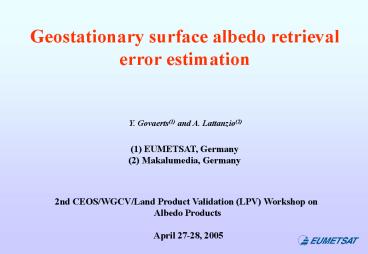Geostationary surface albedo retrieval error estimation PowerPoint PPT Presentation
Title: Geostationary surface albedo retrieval error estimation
1
Geostationary surface albedo retrieval error
estimation
Y. Govaerts(1) and A. Lattanzio(2)
(1) EUMETSAT, Germany (2) Makalumedia, Germany
2nd CEOS/WGCV/Land Product Validation (LPV)
Workshop on Albedo Products April 27-28, 2005
2
METEOSAT MISSIONS STATUS
The Meteosat mission has been conceived in the
early seventies. The primary objective of VIS
band data was the near real-time qualitative
observation of meteorological systems (i.e., to
take picture).
Pre-operational VIS 6 bits
Operational VIS 8 bits
24 years of archive
Need to be consistently calibrated and navigated
3
METEOSAT MISSIONS STATUS
- Majors drawbacks concerning the quantitative use
of the VIS band concern - The unreliable SSR characterization
Development of a SSR model to characterize the
error
4
METEOSAT MISSIONS STATUS
- Majors drawbacks concerning the quantitative use
of the VIS band concern - The unreliable SSR characterization
- The width of the VIS band (surface changes, WV
absorption, )
Surface reflectance Aerosol transmittance
(t0.4) Gaseous transmittance
5
METEOSAT MISSIONS STATUS
- Majors drawbacks concerning the quantitative use
of the VIS band concern - The unreliable SSR characterization
- The width of the VIS band (surface changes, WV
absorption, ) - Navigation problem in the eighties.
The Meteosat system has not been design to fulfil
any climate monitoring requirements
The proposed approach relies on a reliable
estimation of the retrieved surface albedo
retrieval error that explicitly accounts for the
observation system uncertainties.
6
METEOSAT-7 VIS Band Calibration
Govaerts, Y.M. Clerici, M. Clerbaux, N.,
2004, Operational calibration of the Meteosat
radiometer VIS band, IEEE TGARS, 42, 1900- 1914
7
Surface Albedo from Geostationary Obs.
Pinty, B., Roveda, F., Verstraete, M.M., Gobron,
N., Govaerts, Y., Martonchik, J.V., Diner, D.J.,
and Kahn, R.A. (2000) Surface albedo retrieval
from Meteosat Part 1 Theory, Journal of
Geophysical Research, 105, 18099-18112.
8
GEOSTATIONARY SURFACE ALBEDO
INVERSION
Inversion of the forward model
9
GEOSTATIONARY SURFACE ALBEDO
INVERSION Nile delta (winter)
t 0.1, DHR 0.17
10
GEOSTATIONARY SURFACE ALBEDO
INVERSION Nile delta (summer)
t 0.4, DHR 0.21
11
Meteosat -2/7 Albedo Comparison
Meteosat-2 Launch date
1981 Sub-satellite point 0o
Repeat cycle (archive) 30/60
min Digitalisation 6
bits Calibration accuracy 15 Daily Rad.
Noise 12
Meteosat-7 Launch date
1997 Sub-satellite point 0o
Repeat cycle (archive) 30 min Digitalisation
8 bits Calibration accuracy
6 Daily Rad. Noise 7-9
Calibration error budget
12
Meteosat -2/7 Albedo Comparison
Met-7 1-10 May 2004
Met-2 1-10 May 1984
13
(No Transcript)
14
(No Transcript)
15
SURFACE ALBEDO COMPARISON OVER STABE DESERT
Min prob. 90 Max albedo rel. error 10
16
DETECTION OF SIGNIFICANT CHANGES
- Remove the pixels with a QI (probability of the
goodness of the fit) lower than 90
17
SOLUTION PROBABILITY
Met-2
Met-7
18
DETECTION OF SIGNIFICANT CHANGES
- Remove the pixels with a QI (probability of the
goodness of the fit) lower than 90 - Analyse the albedo difference with respect to the
retrieval error
19
RADIOMETRIC RELATIVE ERROR
Met-2
Met-7
20
SURFACE ALBEDO RELATIVE ERROR
Met-2
Met-7
21
DETECTION OF SIGNIFICANT CHANGES
- Remove the pixels with a QI (probability of the
goodness of the fit) lower than 90 - Analyse the albedo difference with respect to the
retrieval error - Keep only differences larger than the respective
error (including calibration error)
22
DETECTION OF SIGNIFICANT CHANGES
A2 1-10 May 1984 A7 1-10 May 2004
(A2-A7)/A7
-75lt
lt75
23
CONCLUSION
- Geostationary observations offer a decisive
advantage to retrieve surface albedo climate data
set thanks to the frequent daily sampling used to
estimate the surface anisotropy and to the
duration of the archive (20 years). - Met-2 and Met-7 agrees within 6 over desert
area. It should be possible to detect significant
(15) temporal surface albedo changes from the
Meteosat archive. - Uncertainty in the SSR characterization is the
major limiting factor.
24
GLOBAL SURFACE ALBEDO
Broadband (0.3 3.0µm) surface albedo derived
from GOES-8/10, MET-5/7 and GMS-5 in 1-10 May 2001

